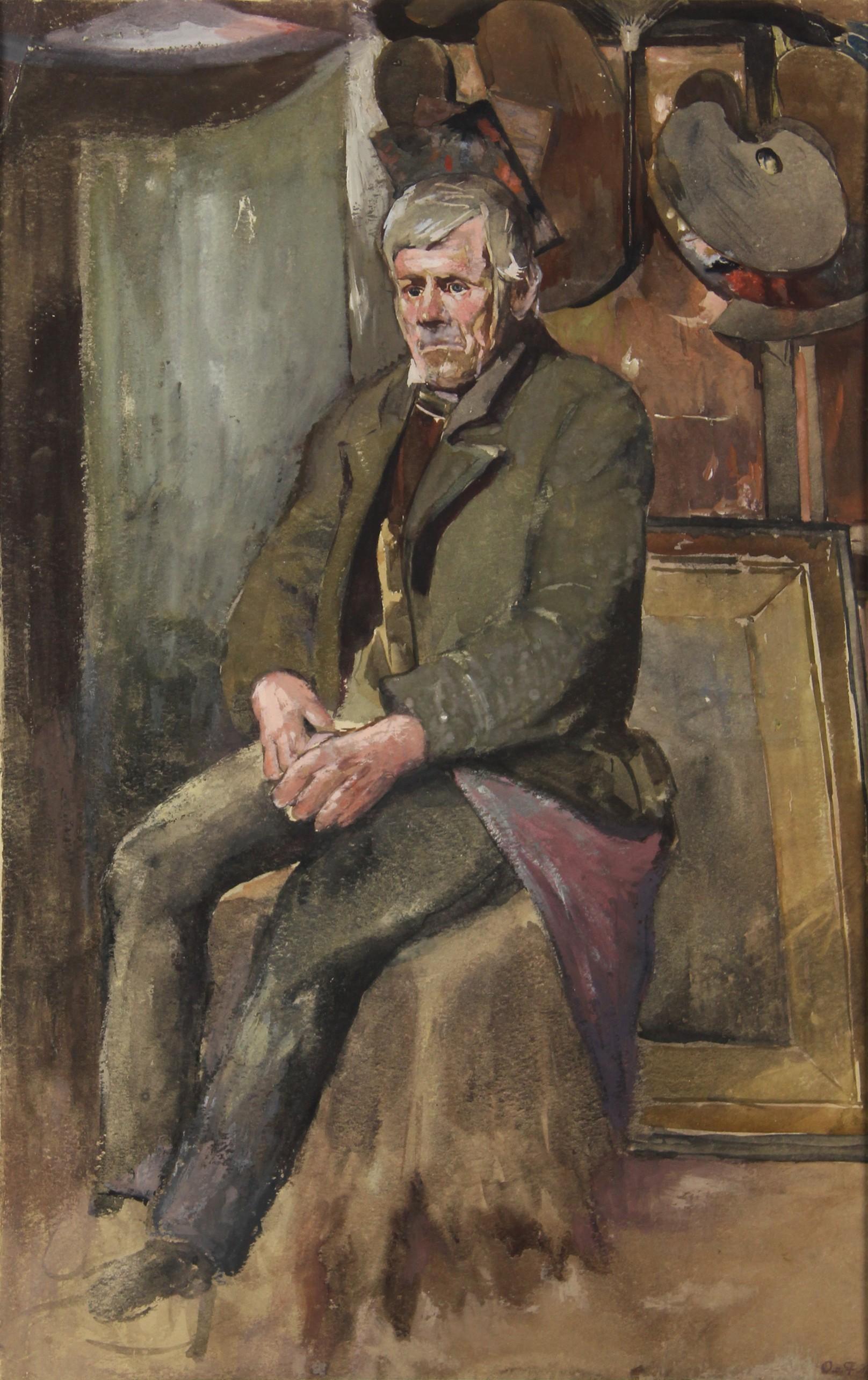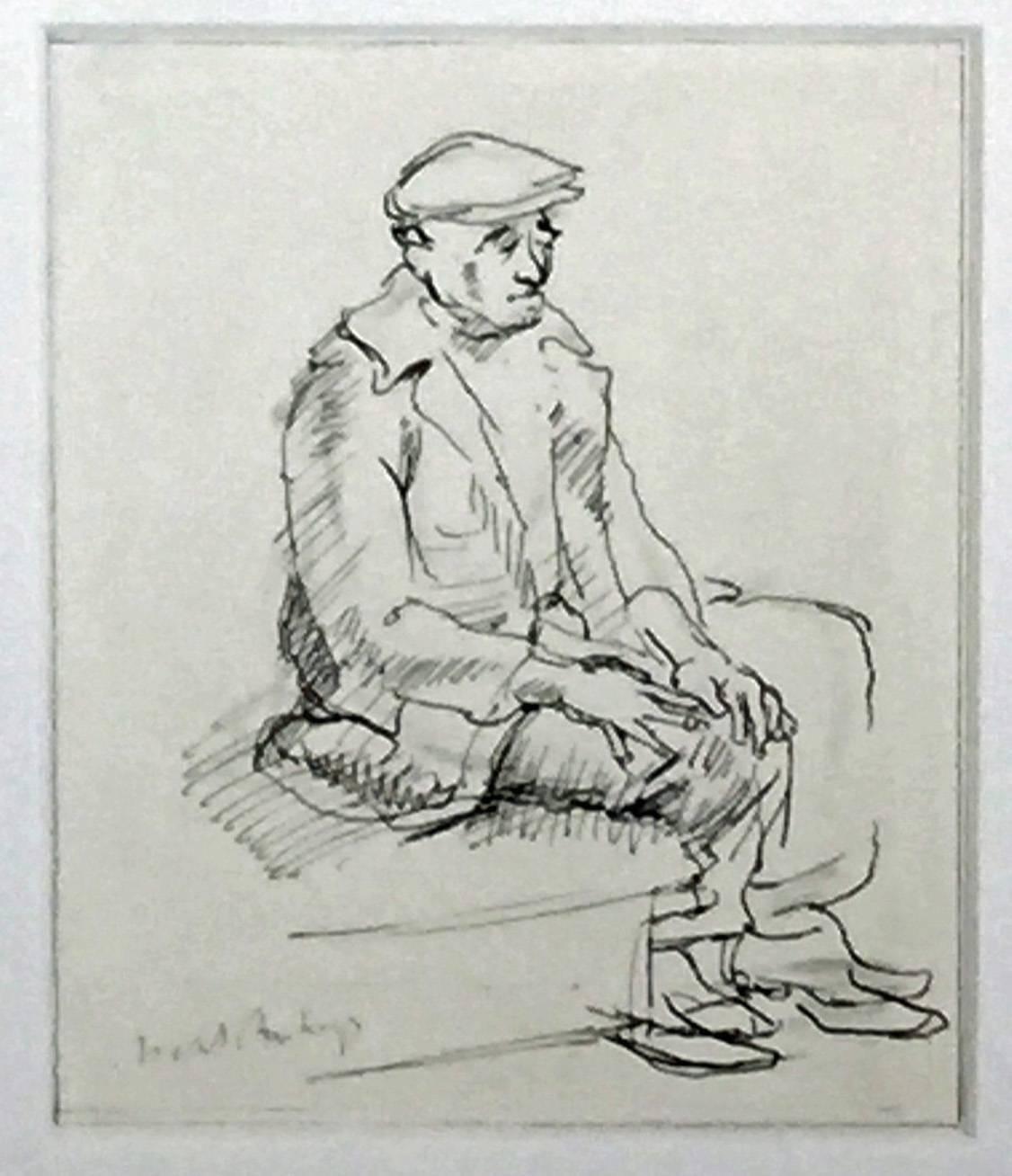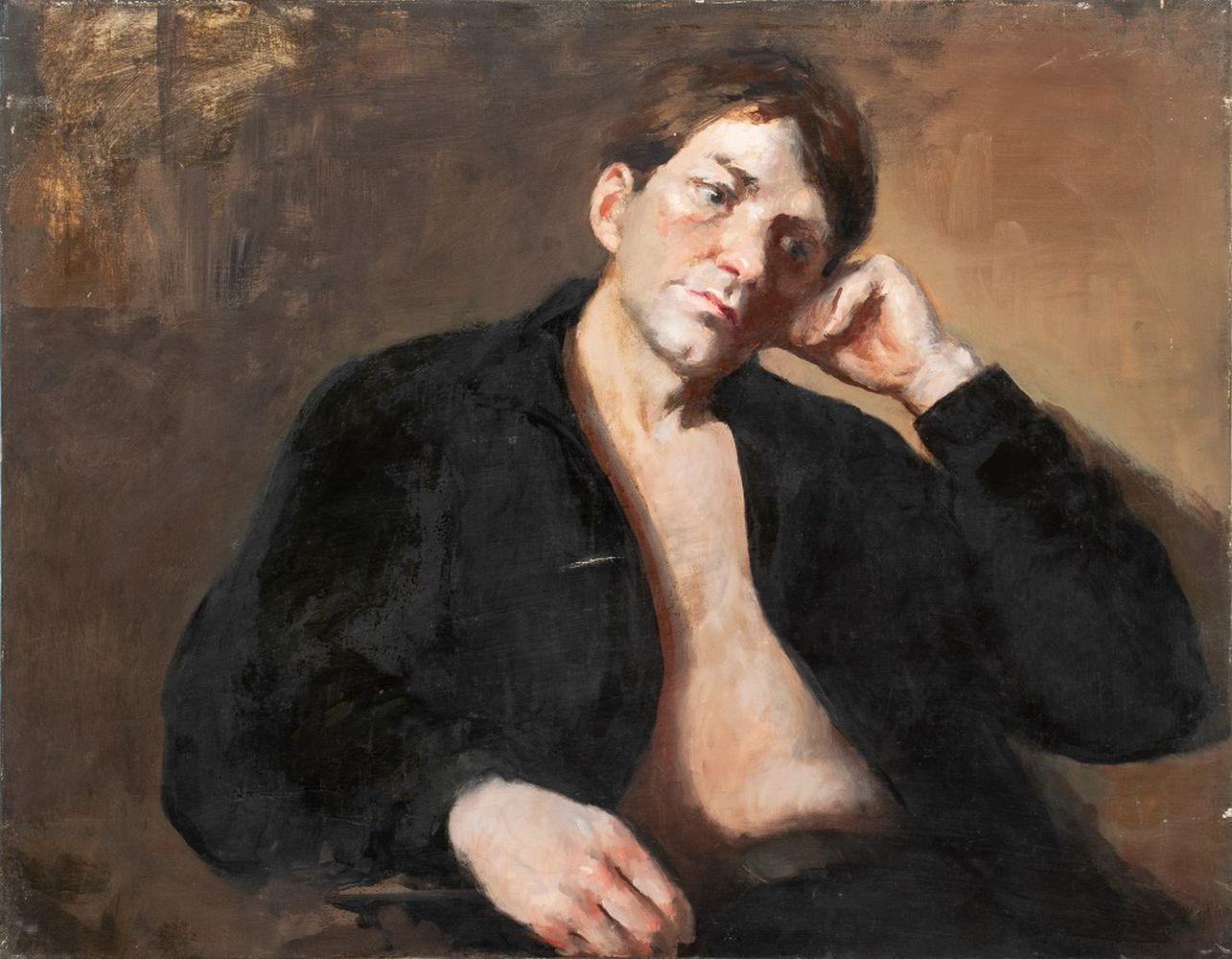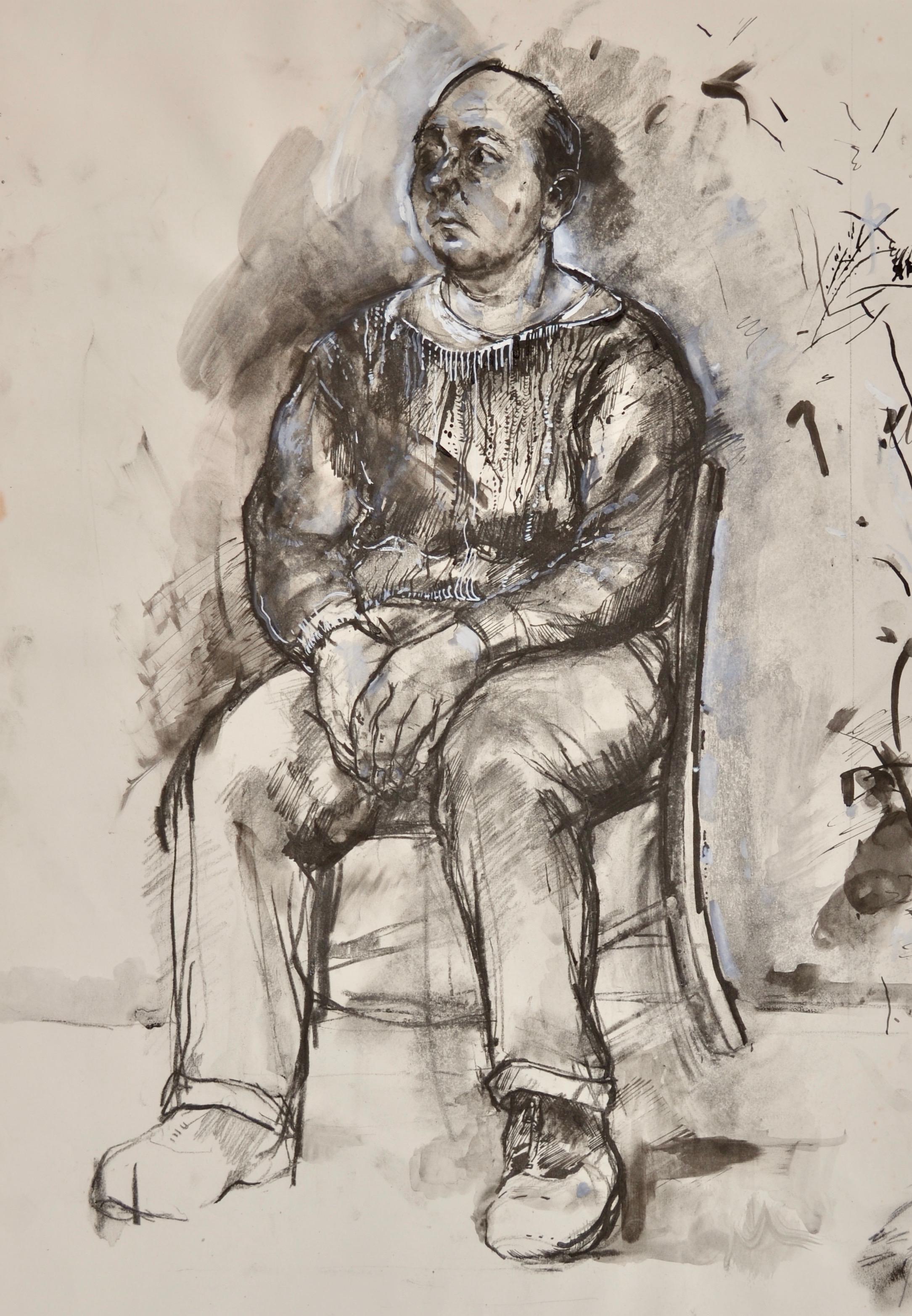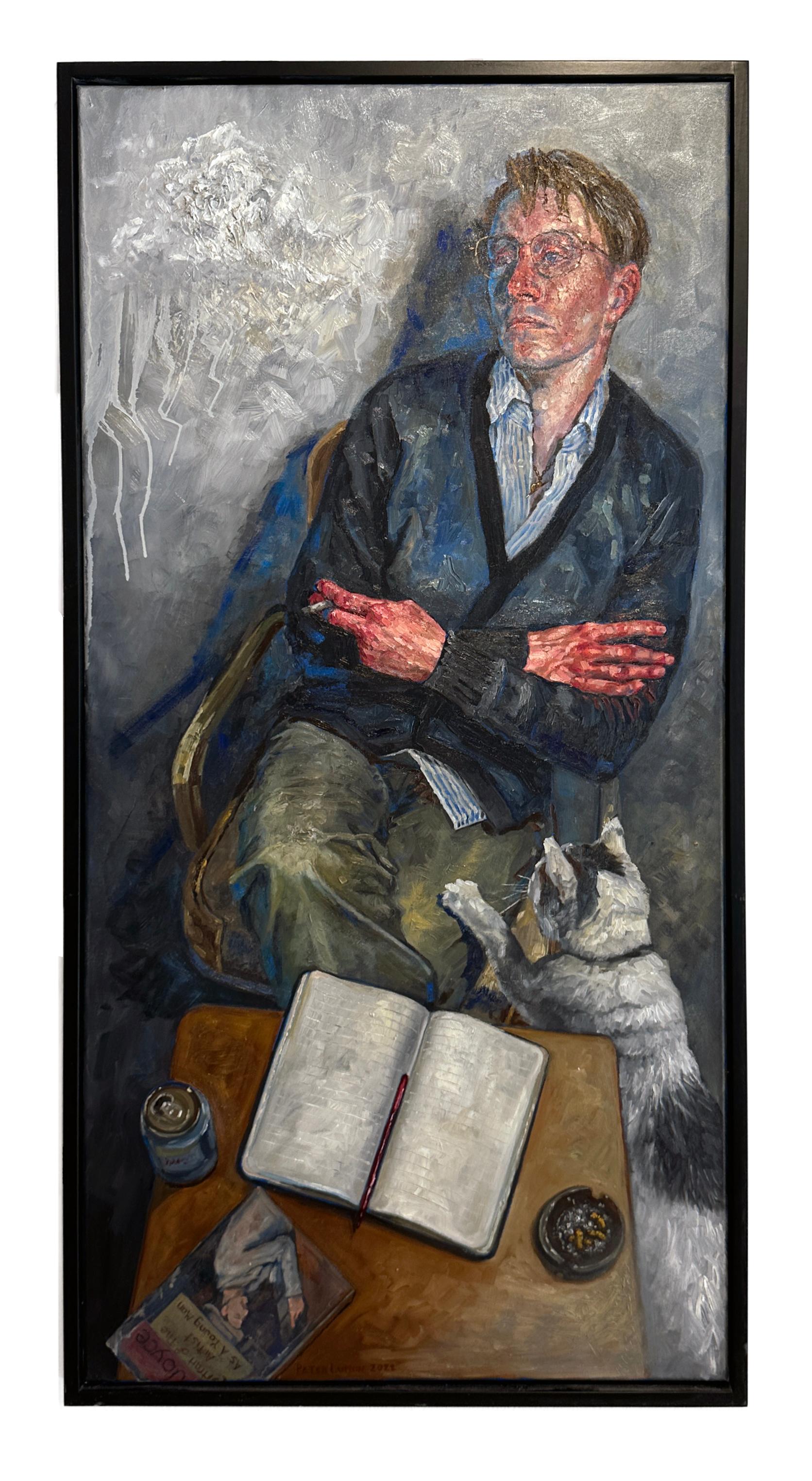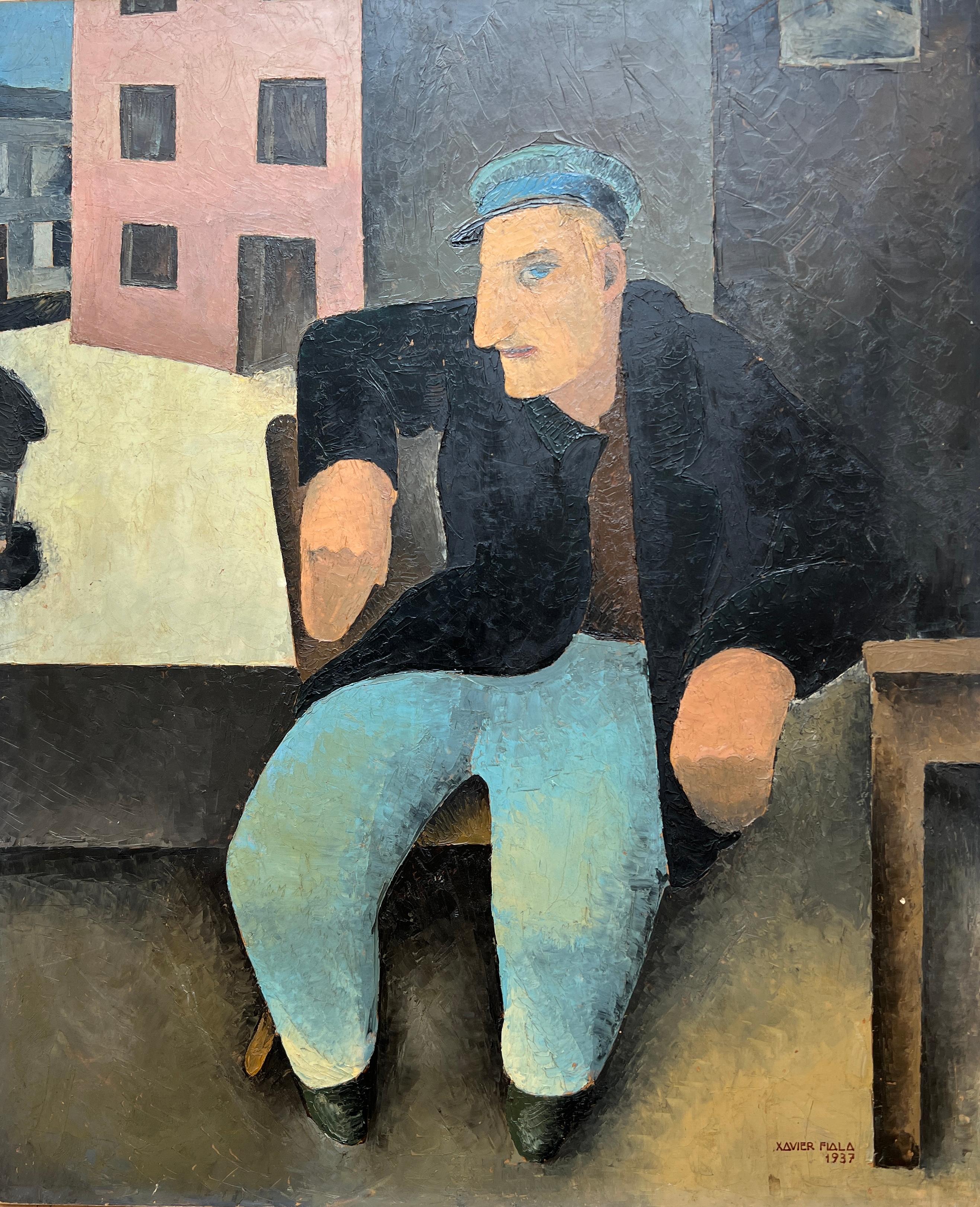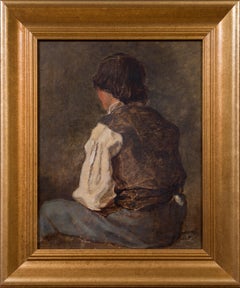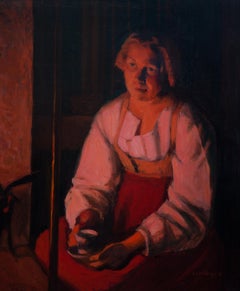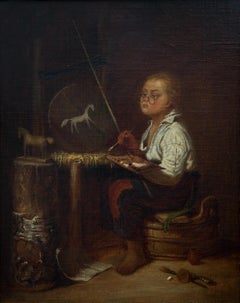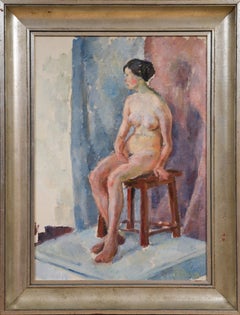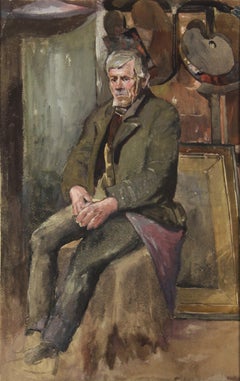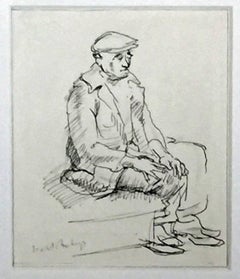Items Similar to The Seated Man – An Intimate Glimpse into Daily Life
Want more images or videos?
Request additional images or videos from the seller
1 of 10
Emerik StenbergThe Seated Man – An Intimate Glimpse into Daily LifeEarly 1900s
Early 1900s
$2,826.39
$3,532.9920% Off
£2,150.94
£2,688.6720% Off
€2,392
€2,99020% Off
CA$3,956.50
CA$4,945.6220% Off
A$4,359.75
A$5,449.6820% Off
CHF 2,261.33
CHF 2,826.6620% Off
MX$51,853.31
MX$64,816.6420% Off
NOK 28,605.15
NOK 35,756.4420% Off
SEK 26,796.96
SEK 33,496.2020% Off
DKK 18,221.94
DKK 22,777.4220% Off
About the Item
This masterfully executed painting by Emerik Stenberg (1873–1927) captures an intimate and atmospheric moment. The composition features a seated man, engrossed in his daily chores, bathed in soft daylight filtering through a window. The subdued lighting and earthy tones create a striking contrast between light and shadow, showcasing Stenberg’s remarkable ability to depict mood and texture.
A Swedish painter, draftsman, and folklife illustrator, Emerik Stenberg was known for his evocative portraits and genre scenes. Trained at the Royal Academy of Fine Arts in Stockholm, he later became a professor of figure painting. Deeply inspired by the cultural traditions of Dalarna, he settled in Leksand, where he found endless artistic inspiration. His works are represented in major Swedish institutions, including the Nationalmuseum, Göteborgs konstmuseum, and Nordiska museet.
This painting exemplifies Stenberg’s gift for capturing the essence of rural life, with a keen eye for atmosphere and human expression. It is a testament to his mastery of light, form, and storytelling.
oil on canvas
unframed: 68 x 56 cm (26 3/4 x 22 in)
framed: 91 x 77 cm (35 7/8 x 30 1/4 in)
Authenticated on the back by his widow, Gully Stenberg
- Creator:Emerik Stenberg (1873 - 1927, Swedish)
- Creation Year:Early 1900s
- Dimensions:Height: 35.83 in (91 cm)Width: 30.32 in (77 cm)
- Medium:
- Movement & Style:
- Period:
- Condition:The painting is in a very good condition with vibrant colors. The original frame has minor imperfections, including older repairs—typical of antique frames. It will be securely packed in a wooden crate. The painting is ready to hang!
- Gallery Location:Stockholm, SE
- Reference Number:1stDibs: LU1445215811682
About the Seller
5.0
Platinum Seller
Premium sellers with a 4.7+ rating and 24-hour response times
Established in 2020
1stDibs seller since 2020
213 sales on 1stDibs
Typical response time: <1 hour
Associations
International Confederation of Art and Antique Dealers' Associations
- ShippingRetrieving quote...Shipping from: Stockholm, Sweden
- Return Policy
More From This Seller
View AllPortrait of a Young Boy Seen from Behind
Located in Stockholm, SE
This intimate oil painting presents a young boy viewed from a three-quarter rear angle, caught in a quiet, reflective moment. The child’s back is turned gently toward the viewer, ren...
Category
1890s Realist Figurative Paintings
Materials
Canvas, Oil, Board
Moments of Reflection Depicting a Woman Sitting by the Fire, Original Oil Paint
By Sam Uhrdin
Located in Stockholm, SE
We are pleased to present a captivating painting by the artist Sam Uhrdin (1886-1964). This beautiful artwork depicts a woman from Dalarna, sitting in front of a warm, glowing fire. The entire painting is bathed in a soft, radiant light, particularly illuminating her face and traditional white/red attire. The woman appears contemplative, lost in thought, perhaps thinking of someone dear to her heart. She is depicted in a kitchen, taking a moment to relax after a day's chores in her home.
Sam Uhrdin's artistic journey began in the early 1900s, he traveled to Stockholm in 1903 to further continue his studies in painting. He worked as a painter during the day and attended various evening schools in the evenings. In 1906, he journeyed to America to work as a sign painter, but he mainly ended up working as an upholsterer. Returning to Leksand in 1909 via London and Paris, his artistic talent gained recognition, and with the help of some patrons, he began studying at the Royal Academy of Fine Arts in 1911, occasionally attending Althin's painting school in Stockholm. Financial circumstances cut his study time short, and his skill as a portrait painter earned him numerous portrait commissions, which further occupied his time.
In 1921, Uhrdin received a scholarship from the Royal Academy, enabling him to embark on a study trip in 1922 to the Netherlands, Belgium, and France, which he had to cut short due to his wife's illness. He later visited places like Spain and Portugal.
Uhrdin's breakthrough came with his portrait of the former Prime Minister Nils Edén, which he executed in 1919. In 1921, he portrayed the participants of the Swedish Academy. Among other representatives of official Sweden captured by Uhrdin were Gustav V, Manne Siegbahn, Ludvig Stavenow, and bishops Gottfrid and Einar Billing. In 1932, he held a solo exhibition at Konstnärshuset in Stockholm, and he participated in various exhibitions, including the Swedish Artists' Association in Stockholm in 1917, Swedish Art at Valand-Chalmers in Gothenburg in 1923, Dalarna Artists displayed at Liljevalchs Konsthall in 1936, and the National Museum's traveling exhibition "Barnet i konsten" (Children in Art...
Category
1940s Realist Portrait Paintings
Materials
Canvas, Oil
Oil Painting Called "The Young Artist" by Swedish Johan Christoffer Boklund
Located in Stockholm, SE
Introducing a captivating oil painting by Johan Christoffer Boklund (1817-1880). The artwork depicts a young boy practicing his painting skills. Seated beside him is a wooden horse t...
Category
19th Century Realist Interior Paintings
Materials
Canvas, Oil, Board
Seated Nude in the Studio – A Modernist Study from the 1920s
Located in Stockholm, SE
This evocative oil painting, titled Studio Muse, depicts a seated nude in a quiet moment of contemplation. The model is shown in profile, resting on a simple wooden stool against a n...
Category
1920s Modern Figurative Paintings
Materials
Oil, Canvas
A Tailor Working at his Desk
Located in Stockholm, SE
Gerhard Ludwig Lahde (Bremen 1765–1833 Köpenhamn)
A Tailor Working at his Desk
Ink and wash on paper, mounted on a 19th-century backing inscribed “G. L. Lahde del.”
unframed: 14.2 ...
Category
Early 19th Century Figurative Drawings and Watercolors
Materials
Ink
An Italian Man With Hat and Scarf by Italian Artist Giuseppe Giardinello
Located in Stockholm, SE
For sale is a beautiful small portrait by the Italian artist Giuseppe Giardinello, whose life spanned from 1887 to 1920. This work of art is a remarkable representation of Giardinell...
Category
Early 20th Century Post-Impressionist Portrait Paintings
Materials
Oil, Wood Panel
You May Also Like
Man sitting in the studio - Thinking about art -
Located in Berlin, DE
Adolph Eduard Otto von Faber du Faur (1828 Ludwigsburg - 1901 Munich). Man sitting in the studio. Watercolour painting, 43 x 27 cm (visible size), 73 x 53 cm (frame), monogrammed at lower right, estate stamp.
Upper right corner neatly repaired, small tear in the wall to the left of the sitter.
- Thinking about art -
About the artwork
The sitter, an elderly man, is seated in a studio on a pedestal reminiscent of an academy hall. The earthy, dark tones give the scene a weighty quality. The lightest tones are found in the incarnate parts of the figure, which do not stand out from the other colours of the picture, but are linked to them. As a result, the sitter's face is both part of and the highlight of the colour references in the picture. The colour of the sitter's skin is reflected in his pink coat, while his white-grey hair matches the colour of the wall next to him. This almost monochrome wall surface, in turn, is connected across the portrait to the framed picture standing on the floor, which seems to have been erased by this correspondence with the empty wall surface. Through the palette, which is positioned directly behind the sitter's head, the reference to painting, which is already given by the studio space, is explicitly linked to the sitter, who thus seems to be contemplating the question of the meaning of art.
This raises the question of whether Faber Du Faur, who had become lonely in his old age, might have painted a self-portrait here in his later years. In addition to the studio setting, the sitter's explicit reference to the palette and the fact that the picture was part of his estate, the only summary elaboration of the body suggests a self-portrait, while the representation of the face is concretised with the wide-open eyes typical of a self-portrait. This concentration on the face gives the impression of the artist's melancholy introspection, captured by the palette and related to the meaning of painting, whose dark character is reinforced by the concealment of the palette hanging on the right of the picture in the light tones so characteristic of Faber Du Faur. In the course of this resignation, Faber du Faur advises his son Hans, who has also become a painter: "Promise me one thing: never move to Munich, they'll kill you here!"
Whoever the sitter may be, the references to painting make the portrait a resigned self-contemplation by Faber Du Faur, focused on art.
About the artist
After leaving school, Otto Faber du Faur entered the service of the Württemberg army, at the same time cultivating his artistic talent. In 1851, on the recommendation of his father Christian Wilhelm, who was himself a battle painter, he spent six months in Munich as an apprentice to Alexander von Kotzebue. In 1852 he was granted a year's leave of absence from military service to study battle painting in the studio of Adolphe Yvon...
Category
1890s Realist Portrait Drawings and Watercolors
Materials
Watercolor
$898 Sale Price
20% Off
SEATED MAN
By Isabel Bishop
Located in Portland, ME
Bishop, Isabel. SEATED MAN. Ink drawing on paper, c. 1932. 5 1/4 x 4 3/4 inches. Signed in pencil.
Category
1930s American Realist Prints and Multiples
Materials
Ink
$520 Sale Price
20% Off
"Seated Man"
Located in Astoria, NY
Robert Holden (American, XX), "Seated Man", Oil on Canvas, 1979-80, signed and Art Students League label verso, unframed.
22" H x 28" W x 1" D.
Provenance: From the Allen Tucker Me...
Category
1970s Post-War Portrait Paintings
Materials
Canvas, Oil
Seated Man - 20th Century British figure drawing by Carolyn Sergeant
Located in London, GB
CAROLYN SERGEANT
(1937-2018)
Seated Man in a Pullover
Signed beneath the mount
Chalk and grisaille wash over traces of pencil, heightened with white
Unframed in mount only
53 by ...
Category
Late 20th Century Realist Figurative Drawings and Watercolors
Materials
Watercolor, Chalk
36 Years - Original Oil Painting, Solitary Male Figure Smoking in a Chair
By Peter Lupkin
Located in Chicago, IL
This painting confronts the art world's prejudice towards age. The book on the table is a copy of James Joyce's Portrait of the Artist as a Young Man. The seated figure is meant to c...
Category
2010s Contemporary Figurative Paintings
Materials
Canvas, Oil
The seated man
Located in Genève, GE
Work on wood
Category
1930s Figurative Paintings
Materials
Oil
More Ways To Browse
1900s Oil On Canvas Portrait
Daily Life Oil Paintings
Embracing Couples Paintings
Galerie Provence
Garden Party Painting
Ginger Williams Cook
Greek Mythology Painting
Haunted Painting
Icon Painting Gold
Indian Man Painting
Jasmine Painting
Kader Boly
Lawyer Painting
Mario Tozzi
Michael Magrin
Native American Artist Paintings
Oil Painting Priest
Oil Paintings Paris Cafe
